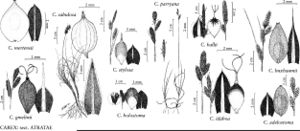Carex hallii
in F. V. Hayden, Prelim. Rep. U.S. Geol. Surv. Montana, 496. 1872.
Plants loosely cespitose. Culms 10–30 cm, distally scabrous. Leaves 2–3.5 mm wide. Inflorescences: proximal bracts shorter than or exceeding inflorescences; spikes erect, short-pendunculate, short-oblong to elongate, 5–20 × 3–5 mm; lateral 1–2 spikes pistillate or absent, none longer than 1/2 the length of terminal spike; 2d lateral spikes, when present, sometimes separate; distal spikes usually reduced to 1–3 perigynia; terminal spike usually pistillate, also staminate. Pistillate scales light to dark brown, distal margins broadly hyaline, ovate or lanceolate, equaling or barely exceeding and as wide as perigynia, midvein lighter colored than body, conspicuous, often raised, prominent, and distally scabrous, apex rounded or acute to mucronate. Perigynia ascending, greenish yellow or brown, veinless, elliptic, 2–3 × 2–2.5 mm, apex abruptly beaked, papillose; beak 0.2–0.3 mm, truncate or obscurely bidentate, serrulate. Achenes nearly filling body of perigynia.
Phenology: Fruiting May–Aug.
Habitat: Moist alkaline meadows
Elevation: 200–3200 m
Distribution

Man., Colo., Minn., Nebr., N.Dak., Wyo.
Discussion
Selected References
None.
